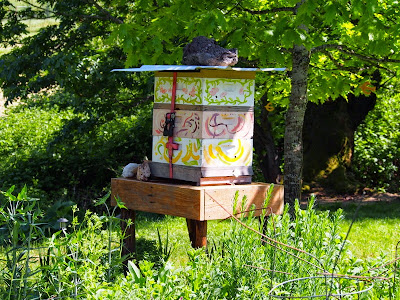There are two table rocks just out of Medford. One is called Upper Table Rock and the other is Lower Table Rock. I have found no reason why one is upper and the other is lower. The area, which covers 4,864 acres, is managed jointly by the BLM and the Nature Conservancy. Over 50,000 people hike the trails to the top each year. And we were two of them.
We decided to hike the Lower Table Rock because it looked more challenging.
Of course.
Here is a cool map that gives you an idea of the route we trod. The little zig-zaggy line that goes up the cliff is vastly underestimated.
After reading this in the car park, I decided to go back to the car and retrieve my pepper spray.
It was a perfect day and the wildflowers were in full bloom. Lucky us!
The hike is about 5.4 miles, according to some sources, which includes the walk on top of the plateau.
A row of electricity pylons guards the way, buzzing fiercely at the trespassers.
The first part of the trail was an easy slope and there were lots of trees, especially our favourite madrones.
In fact, eew.
Pretty soon the gravel trail steepened and I began to have concerns about the stability of my ankles on the way down.
No matter, traipse on!
There were many different wildflowers on the way up the trail, changing with the elevation as we ascended higher and higher. Not all of the flower photos turned out, so this is only about half of what we saw. I had forgotten how difficult it is to focus on some flower colours. Here are the best ones, mostly identified.
 |
| Indian paintbrush |
 |
| Dwarf onion (allium) |
 |
| Not a flower |
 |
| Vetch |
I wish I knew the name of this, but I have been unable to find it, in spite of it being all over the area as well as out in Central Oregon. Some kind of silverpuff, I think.
 |
| Camas lily |
These galls were all over the trees at the lower elevation. They can be caused by insects, mites, nematodes, bacteria, or fungi. They damage the tree, which causes the tree to produce larger amounts of growth hormone, which result in galls such as these. An attractive solution to the problem.
 |
| Desert parsley |
 |
| Blue-eyed Mary |
 |
| Monkey flower |
 |
| Forktooth Ookow. I kid you not. |
 |
| Henderson's stars |
 |
| Western columbine |
 |
| Lupine |
 |
| Tolmie's cat's-ears, AKA cat's ear lily, AKA mariposa lily |
 |
| Wood rose with, I believe, poison oak |
I love this twisty madrone.
Right at the top of the trail the path divides and you can catch a view from the edge of the cliff if you go left over a very rocky terrain. The view was breathtaking and you could probably go home happy after going this far, but we wanted to have the whole experience, of course.
 |
| Looking over Upper table rock |
So on we went.
The plateau is a mounded prairie habitat and has a unique plant community. A thin layer of granular rock covers impermeable volcanic rock, allowing water to collect during the winter in shallow depressions and creating what is known as vernal pools. It is a rare environment and supports a threatened species of fairy shrimp and an endangered plant called dwarf woolly meadowfoam.
This is a very hot and dry area as soon as the pools dry up, which they already had by the time we were there, and the flowers are very different from the wooded areas on the way up.
 |
| Arrow Leafed balsamroot |
 |
| Longhorn plectritis |
As we walked along this very civilized path, we could see a group of people coming towards us who were moving around in a very curious manner. We wondered what they were doing.
And then we saw for ourselves. Hundreds and hundreds of little tiny frogs were crossing the path. The pools were almost completely gone, just a remnant of dampness left, so they must have been on their way to seek shelter in the trees. I wondered what happens to the fairy shrimp in the summer. Apparently, they die after laying eggs that can withstand extreme heat and arid conditions and the eggs hatch as soon as the pools fill up. Cool.
It was impossible to avoid the little critters, as they were thickly underfoot, but they seemed to avoid our big clompy feet just fine. Which is just as well, because I would have been sad to squash them.
Lizards were also in evidence, basking in the sun.
The ground was thickly covered with grasses and wildflowers.
It seemed like a long mile, especially when we kept getting distracted with things like frogs, but we finally made it to the other side. We were overlooking Kelly Slough, a unique wetland habitat that is home to many aquatic birds.
We walked over to a patch of trees and spent a nice lazy interval sitting in some welcome shade and eating snacks, then wended our way back across the plateau and down the trail, which was just as precarious as I had feared. Why I ever go hiking without my poles I do not know. About halfway down I started to get blisters on all of the toes of my right foot, and by the time we got to the car I could hardly walk on them.
No matter. After a little rest back at the house and donning a pair of sandals, I was good for the rest of the day.
This is an awesome hike, definitely best done in the spring. In fact, I would do it again in April, as it would be cooler in temperature and the pools would still be in evidence. The wildflowers would also be different and, I suspect, more numerous, so I think we will do this again some year.













































































